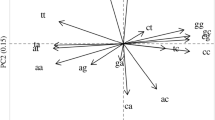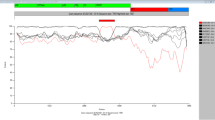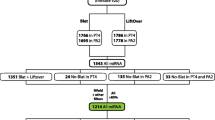Summary
The present study is a detailed computer-assisted analysis of the feline leukemia virus gag gene nucleotide sequence together wit its flanking sequences (ST-FeLV GAG) that is compared with the aligned sectors of the Moloney strain of murine leukemia virus (Mo-MuLV GAG) and of three strains of feline sarcoma virus. It shows that perfectly matched repeated oligomers up to 13 nucleotides long are overrepresented and scattered throughout both ST-FeLV GAG and Mo-MuLV GAG, in noncoding and coding sectors, with no stringent correlation to codon usage in ST-FeLV gPr80gag. Many repeated oligomers share a core consensus that is intriguingly part of the inverted repeat at the termini of the long terminal repeat. Local scrambled repetitions of nucleotide subsequences have been found; they suggest a model of molecular evolution byslippage-like mechanisms. Thus, viral genomes could be subject to the same evolutionary mechanisms that are now known to be operating extensively in eukaryotic genomes. The data are discussed in light of putative patterns of molecular evolution.
Similar content being viewed by others
References
Adams J (1982) Gene duplication and the birthday problem. Nature (London) 296:176
Barker WC, Ketcham LK, Dayhoff M (1978) A comprehensive examinatio of protein sequences for evidence of internal gene duplication. J Mol Evol 10:265–281
Berger EM (1978) Pattern and chance in the use of the genetic code. J Mol Evol 10:319–323
Dhar R, McClements WL, Enquist LW, Vande Woude GF (1980) Nucleotide sequences of integrated Moloney sarcoma provirus long terminal repeats and their host and viral junctions. Proc Natl Acad Sci USA 77:3937–3941
Doolittle WF, Sapienza C (1980) Selfish genes, the phenotype paradigm and genome evolution. Nature (London) 284:601–603
Dover G (1982) Molecular drive: a cohesive mode of species evolution. Nature (London) 299:111–117
Golding GB, Glickman BW (1985) Sequence-directed mutagenesis: evidence from a phylogenetic history of human α-interferon genes. Proc Natl Acad Sci USA 82:8577–8581
Grantham R, Gautier C, Gouy M (1980a) Codon frequencies in 119 individual genes confirm consistent choices of degenerate bases according to genome type. Nucleic Acids Res 8:1893–1912
Grantham R, Gautier C, Gouy M, Mercier R, Pavé A (1980b) Codon catalog usage and the genome hypothesis. Nucleic acids Res 8:r49-r62
Greaves DR, Patient RK (1985) (AT)n is a interpersed repeat in theXenopus genome. EMBO J 4:2617–2626
Gribskov M, Devereux J, Burgess RR (1984) The condon preference ploat: graphic analysis of protein coding sequences and prediction of gene expression. Nucleic Acids Res 12:539–549
Hampe A, Laprevotte I, Galibert F, Fedele LA, Sherr CJ (1982) Nucleotide sequences of feline retroviral oncogenes (v-fes) provide evidence for a family of tyrosine-specific proteini kinase genes. Cell 30:775–785
Hampe A, Gobet M, Sherr CJ, Galibert F (1984) Nucleotide sequence of the feline retroviral oncogene v-fms show unexpected homology with oncogenes encoding tyrosine-specfici protein kinases. Proc Natl Acad Sci USA 81:85–89
Hénaut A, Vigier P (1985) Etude des contraintes qui s'exercent sur la succesion des bases dans un polynuclétotide: la signification de la dégénérescence du code. CR Acad Sci Paris 301:277–282
Higashi Y, Tanae A, Inoue H, Fujii-Kuriyama Y (1988) Evidence for freuquent gene conversion in the steroid 21-hydroxylase P-450(C21) gene: implications for steroid 21-hydroxylase deficiency. Am J Hum Genet 42:17–25
Ikemura T, Ozeki H (1982) Codon usage and transfer RNA contents: organism-specific codon-choice patterns in reference to the isoacceptor contents. Cold Spring Harbor Symp Quant Biol 47:1087–1097
Jeffreys AJ, Wilson V, Thein SL (1985) Hypervariable ‘ministellite’ regions in human DNA. Nature (London) 314:67–73
Karlin S, Blaisdell BE (1987) A model for the development of the tadem repeat units in the EBV ori-P region and a discussion of their possible function. J Mol Evol 25:215–229
Laprevotte I, Hampe A, Sherr CJ, Galibert F (1984) Nucleotide sequence of thegag gene andgag-pol function of feline leukemia virus. J Virol 50:884–894
Linial M, Blair D (1982) Genetics of retroviruses. In: Weiss R, Teich N, Varmus H, Coffin J (eds) Molecular biology of tumor viruses: RNA tumor viruses, chaper 7. Cold Spring Harbor Laboratory Press, Cold Spring Harbor NY, pp649–783
Lipman DJ, Wilbur WJ, Smith TF, Waterman MS (1984) On the statistical significance of nucleic acid similarities. Nucleic Acid Res 12:215–226
Needleman SB, Wunsch CD (1970) A general method appalicable to the search for similarities in the amino acid sequences of two proteins. J Mol Biol 48:443–453
Novak U (1984) Structure and properties of a highly repetitive DNA sequence in sheep. Nucleic Acids Res 12:2343–2350
Ohno S (1984) Birth of a unique enzyme fro an alternative reading frame of the preexisted, internally repetitious coding sequence. Proc Natl Acad Sci USA 81:2421–2425
Ohno S, Epplen JT (1983) The primitive code and repeats of base oligomers as the primordial protein-encoding sequence. Proc Natl Acad Sci USA 80:3391–3395
Orgel LE, Crick FHC (1980) Selfish DNA: the ultimate parasite. Nature (London) 284:604–607
Oroszlan S, Gilden RV (1980) Primary structure analysis of retrovirus proteins. In: Stephenson JR (ed) Molecular biology of RNA tumor viruses, chapter 8. Academic Press, New York, pp 299–344
Salser W (1977) Globin mRNA sequences: analysis of base pairing and evolutionary implications. Cold Spring Harbor Symp Quant Biol 42:985–1002
Shepherd NS, Schwarz-Sommer Z, Blumberg vel Spalve J, Gupta M, Wienand U, Saedler H (1984) Similarity of theCin1 repetitive famility ofZea mays to eukaryotic transposable elements. Nature (London) 307:185–187
Sherr CJ, Fedele LA, Oskarsson M, Maizel J, Vande Woude G (1980) Molecular cloning of Synder-Theilen feline leukemia and sarcoma viruses: comparative studies of feline sarcoma virus with its natural virus and with Moloney murine sarcoma virus. J Virol 34:200–212
Schinnick TM, Lerner RA, Sutcliffe JG (1981) Nucleotide sequence of Moloney murine leukaeeia virus. Nature (London) 293:543–548
Smith GP (1976) Evolution of repeated DNA sequences by unequal crossover. Science 191:528–535
Smith GR (1983) Chi hotspots of generalized recombination. Cell 34:709–710
Smith TF, Waterman MS (1981) Identification of common subsequences. J Mol Biol 147:195–197
Southern E (1972) Repetitive DNA in mammals. In: Pfeiffer RA (ed) Modern aspects of cytogenetics: constitutive heterochromatin in man. Symposia Medica Hoechst No 6, Schattauer Verlag, Stuttgart, pp19–27
Staden R (1982) An interactive graphics program for comparing and aligning nucleic acid and amino acid sequences. Nucleic Acids Res 10:2951–2961
Stahl FW (1987) Genetic recombination. Sci Am 256:52–63
Tautz D, Trick M, Dover GA (1986) Cryptic simplicity in DNA is amajor source of genetic variation. Nature (London) 322:652–656
Van Beveren C, Van Straaten F, Galleshaw JA, Verma IM (1981) Nucleotide sequence of the geome of a murine sarcoma virus. Cell 27:97–108
Vigier P, Hénaut A (1986) Etude des contraintes qi s'exercent sur la succession des bases dans un polynucléotide. II. La distribution des tétranucléotides complémentaries dans les gènes d'Escherichia coli et des bactériophages lambda et T7. CR Acad Sci Paris 302:1–6
Author information
Authors and Affiliations
Rights and permissions
About this article
Cite this article
Laprevotte, I. Scrambled duplications in the feline leukemia virusgag gene: A putative pattern for molecular evolution. J Mol Evol 29, 135–148 (1989). https://doi.org/10.1007/BF02100112
Received:
Revised:
Issue Date:
DOI: https://doi.org/10.1007/BF02100112




